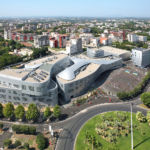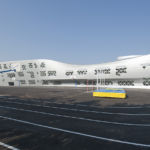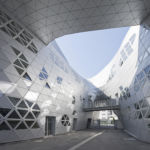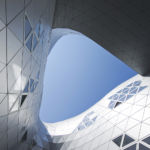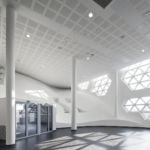Hotel / Business Management School Georges-Freche
Montpellier, France
Built on 3.95 acres in the ZAC Port Marianne area to the East of Montpellier, the hotel-school Lycée Georges Frêche transforms the landscape and provides it with a distinct urban identity.
Massimiliano and Doriana Fuksas’ project, which is developed horizontally, comes across as a single entity. It has a formal diversity, compact volumes and sculptural shapes. The volumetric complexity, which can be seen even inside the building, gives every room its own spatial individuality. The School includes:
- Two main buildings connected by footbridges that cross a tree planted central courtyard
- Accommodation for students (75 beds spread over three floors)
- Housing for management (10 apartments over 5 floors)
- Gym
- Athletic Track and sports ground situated outside
The entrance for the students and the professors is through an arch while the entrance for the clients is on an opposite side. The two buildings that form the edifice make up the sculptural mass around which the gym, the students’ residence and the management’s housing gravitate.
The first building, situated on the Titien Road, has three floors and includes: the multi-purpose room, the exhibition gallery, the administrative offices, the classrooms and the canteen that has exits leading towards the recreational areas outside.
The second building is distinguished by its Y form and is on two floors. Here, there are the spaces for the vocational teaching as well the areas dedicated to the hotel and the gastronomic restaurant: a hotel that is open to the public (12 rooms, 6 of which are two/three star, 4 four star and 2 suites); three restaurants, one of which is a gastronomic restaurant (50 places), a brasserie and a teaching restaurant (200 places in total), a bread-making workshop and a pastry making classroom. The gastronomic restaurant, the brasserie and the 4 star hotel showcase the School’s excellence and are the most important areas of the Project.
Massimiliano and Doriana Fuksas have designed the interior, the areas accessible to the public and the spaces devoted to the gastronomic sector and to the hotel. In the entrance hall leading to the gastronomic restaurant and to the hotel, there is a reception desk: a white lacquered sculptural object, mirroring the fluid forms and the solid character of the structure. The desk is covered with materials that are used for making boat hulls. Different types of originally designed tables and chairs define the spaces dedicated to the interaction between the public and the students. There is also the limited edition furniture specially made for the hotel. The School walls and those of the students’ residence are painted in a different colour on each floor, with the shades ranging from yellow to green to magenta and orange. The colours serve as signage to distinguish the different spaces and activities.
The project can be called “experimental” as much for its triangular shaped aluminium façade as for the use of reinforced concrete. Both materials have been adapted in order to be able to adopt specific shapes – curved and fluid – as required by the structure.
The facades of the building have been constructed using 17,000 cases of anodized aluminum in triangular shapes. Each aluminum case is unique and bears its own specific bar code in order that it can be identified for its specific situation on the façade. The interaction between the facades reinforces the dynamic tension between the solid materials and the cavities, the light and the shadows, that are an inherent part of the projet. The geometric design of the aluminum “skin” is developed further to apply to the 5,000 triangular glass frames that are mounted on metal nets. Each of these is different.
The structure of the building is made from reinforced concrete. To reproduce the curves of the volumes, the project has used “shotcrete” technology. Photovoltaic panels have been installed on the roof of the first building (multi-purpose room, exhibition gallery, administrative offices, classrooms, canteen) as well as on the roof of the apartments for the management.
SITE
401, rue le Titien 34000 Montpellier, France
PERIOD
2007-2012
Competition 2007
(Massimiliano Fuksas; Jakob + MacFarlane ; Borja Huidobro; Porro et de la Noue; Corinne Vezzoni)
Won competition: April 2007
Building site: January 2010
Inauguration: September 2012
PROGRAM
classrooms, offices, exhibition room, hotel (12 rooms, 6 two/three star, 4 four star and 2 suites), three restaurants (200 places in total), accommodation for students (75 beds), housing for management (10 apartments), gym, athletic track and sports ground
CLIENT
Région Languedoc-Roussillon
DEVELOPER
Languedoc-Roussillon Aménagement
ARCHITECTS
Massimiliano and Doriana Fuksas
INTERIOR DESIGN
Fuksas Design
CONTRACTORS
GFC – structure
SMAC – façades
BARSALOU – frames
SURFACES
Net surface: 23,600 sq.m.
Gross surface: 25,736.80 sq.m.
Area surface:16,500 sq.m.
CONSULTANTS
ALTIA – Acoustics
NEVEUX-ROUYER – Landscape Architects
ALMA Consulting – Kitchen design
ENGINEERING
IOSIS
ARTISTIC INTERVENTIONS
Matali Crasset
COST
79.9M € excluding teaching equipment;
2.5 M € in educational facilities
Related projects


